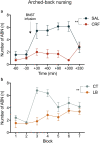Corticotropin-releasing factor infusion in the bed nucleus of the stria terminalis of lactating mice alters maternal care and induces behavioural phenotypes in offspring
- PMID: 33204022
- PMCID: PMC7672063
- DOI: 10.1038/s41598-020-77118-7
Corticotropin-releasing factor infusion in the bed nucleus of the stria terminalis of lactating mice alters maternal care and induces behavioural phenotypes in offspring
Abstract
The peripartum period is accompanied by numerous physiological and behavioural adaptations organised by the maternal brain. These changes are essential for adequate expression of maternal behaviour, thereby ensuring proper development of the offspring. The corticotropin-releasing factor (CRF) plays a key role in a variety of behaviours accompanying stress, anxiety, and depression. There is also evidence that CRF contributes to maladaptations during the peripartum period. We investigated the effects of CRF in the bed nucleus of the stria terminalis (BNST) of lactating mice during maternal care and analysed locomotor activity and anxiety-like behaviour in the offspring. The BNST has been implicated in anxiety behaviour and regulation of the stress response. The effects of intra-BNST CRF administration were compared with those induced by the limited bedding (LB) procedure, a model that produces altered maternal behaviour. BALB/cJ dams were exposed to five infusions of CRF or saline into the BNST in the first weeks after birth while the LB dams were exposed to limited nesting material from postnatal days (P) 2-9. Maternal behaviour was recorded in intercalated days, from P1-9. Offspring anxiety-like behaviour was assessed during adulthood using the open-field, elevated plus-maze, and light/dark tests. Both intra-BNST CRF and LB exposure produced altered maternal care, represented by decreased arched-back nursing and increased frequency of exits from the nest. These changes in maternal care resulted in robust sex-based differences in the offspring's behavioural responses during adulthood. Females raised by CRF-infused dams exhibited increased anxiety-like behaviour, whereas males presented a significant decrease in anxiety. On the other hand, both males and females raised by dams exposed to LB showed higher locomotor activity. Our study demonstrates that maternal care is impaired by intra-BNST CRF administrations, and these maladaptations are similar to exposure to adverse early environments. These procedures, however, produce distinct phenotypes in mice during young adulthood and suggest sex-based differences in the susceptibility to poor maternal care.
Conflict of interest statement
The authors declare no competing interests.
Figures








Similar articles
-
Hypoactivation of CRF receptors, predominantly type 2, in the medial-posterior BNST is vital for adequate maternal behavior in lactating rats.J Neurosci. 2014 Jul 16;34(29):9665-76. doi: 10.1523/JNEUROSCI.4220-13.2014. J Neurosci. 2014. PMID: 25031406 Free PMC article.
-
Altered maternal profiles in corticotropin-releasing factor receptor 1 deficient mice.BMC Neurosci. 2007 Mar 1;8:17. doi: 10.1186/1471-2202-8-17. BMC Neurosci. 2007. PMID: 17331244 Free PMC article.
-
Brain CRF-binding protein modulates aspects of maternal behavior under stressful conditions and supports a hypo-anxious state in lactating rats.Horm Behav. 2016 Aug;84:136-44. doi: 10.1016/j.yhbeh.2016.06.009. Epub 2016 Jun 28. Horm Behav. 2016. PMID: 27368148
-
When mothers neglect their offspring: an activated CRF system in the BNST is detrimental for maternal behavior.Arch Womens Ment Health. 2019 Jun;22(3):409-415. doi: 10.1007/s00737-018-0897-z. Epub 2018 Aug 4. Arch Womens Ment Health. 2019. PMID: 30078057 Review.
-
Mom doesn't care: When increased brain CRF system activity leads to maternal neglect in rodents.Front Neuroendocrinol. 2019 Apr;53:100735. doi: 10.1016/j.yfrne.2019.01.001. Epub 2019 Jan 23. Front Neuroendocrinol. 2019. PMID: 30684507 Review.
Cited by
-
CRF binding protein activity in the hypothalamic paraventricular nucleus is essential for stress adaptations and normal maternal behaviour in lactating rats.Neurobiol Stress. 2024 Mar 27;30:100631. doi: 10.1016/j.ynstr.2024.100631. eCollection 2024 May. Neurobiol Stress. 2024. PMID: 38601362 Free PMC article.
-
Translational models of stress and resilience: An applied neuroscience methodology review.Neurosci Appl. 2024 Apr 4;3:104064. doi: 10.1016/j.nsa.2024.104064. eCollection 2024. Neurosci Appl. 2024. PMID: 40656062 Free PMC article. Review.
-
Vulnerability and resilience to prenatal stress exposure: behavioral and molecular characterization in adolescent rats.Transl Psychiatry. 2023 Nov 22;13(1):358. doi: 10.1038/s41398-023-02653-6. Transl Psychiatry. 2023. PMID: 37993429 Free PMC article.
-
Paternal transmission of behavioural and metabolic traits induced by postnatal stress to the 5th generation in mice.Environ Epigenet. 2022 Nov 17;8(1):dvac024. doi: 10.1093/eep/dvac024. eCollection 2022. Environ Epigenet. 2022. PMID: 36518875 Free PMC article.

